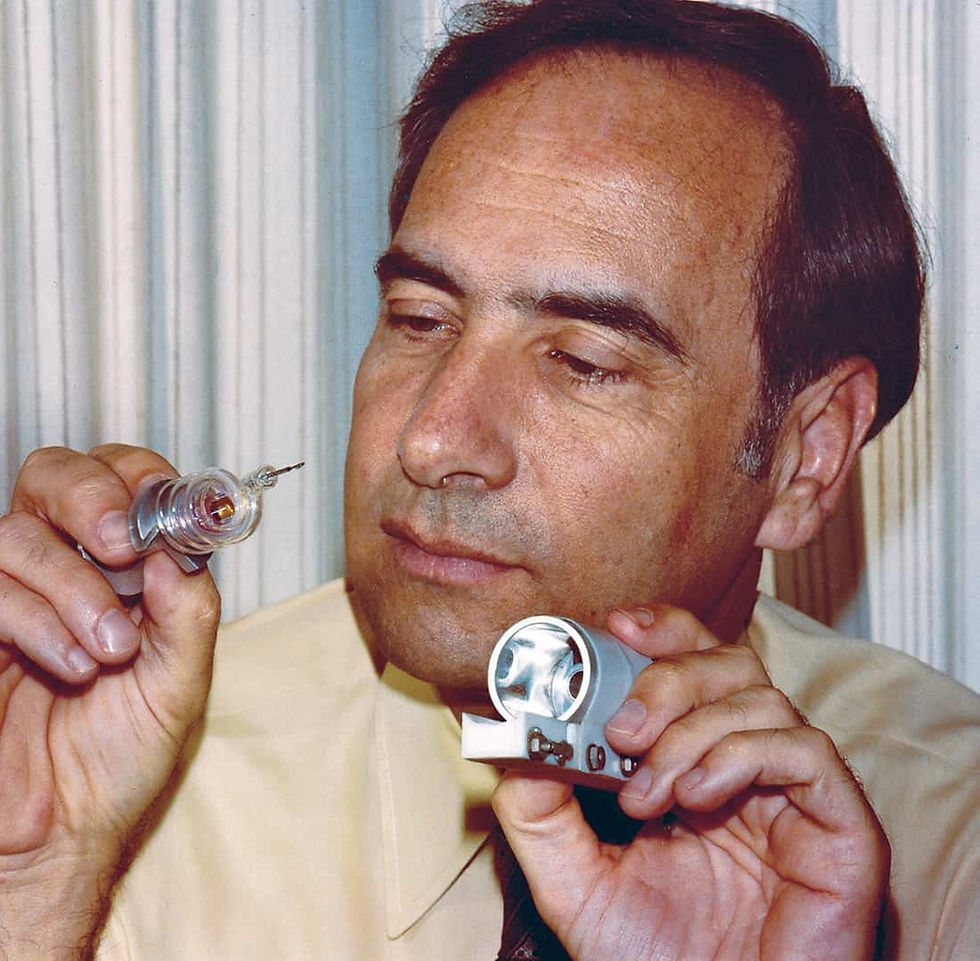Subhas Chandra Bose: A Love Story Illuminated by Vedic Astrology
- Sunil Dutt

- Jul 18
- 7 min read
Updated: Aug 10

The Astrological Update on Subhas Chandra Bose
Astrodatabank recently updated Subhas Chandra Bose’s birth details. The rating changed from A to AA, and the birth time was adjusted from 12:15 PM to 12:00 PM (midday). The site mentions, "Sy Scholfield shared a screenshot of Bose's father's diary from 23 January 1897, saying, 'A son was born at midday.' This diary photo, posted by Prime Minister Narendra Modi on Twitter on 23 January 2020, led to the AA rating (official record)."
Previously, the A-rated entry (based on memory) used 12:15 PM, as noted by Arthur Blackwell in I AM, November 1956, "as used by Indian astrologers." A BBC Hindi article published on January 23, 2024, about Subhas Chandra Bose’s love story with Emilie Schenkl sparked my curiosity. It inspired me to explore their romance using Vedic astrology’s Vimshottari Dasha system. By correlating key life events with planetary periods, I rectified Bose’s birth time to 12:10 PM with Dhanu Navamsa. I will now trace these events using the Vimshottari Dasha system.




The Significance of Astrological Combinations
The BBC Hindi article on Subhas Chandra Bose’s love story with Emilie Schenkl highlights the significance of astrological combinations supporting love marriage. In Bose’s Vedic chart, the 5th lord, Sun, is strongly positioned in the 10th house. This signifies prominence and recognition, though it lacks a direct link to the 7th house of marriage.
A key combination arises as Jupiter, the 9th lord—governing the 5th house from the 5th (deep romance) and the 12th lord (foreign connections)—mutually aspects Venus, the 7th lord. This connection fosters romantic fulfillment and a bond with a foreign partner. This connection is reinforced by Venus residing in Jupiter’s Nakshatra (Purvabhadrapada) and Jupiter in Venus’s Nakshatra (Purva Phalguni), indicating a karmic and romantic tie with a woman from abroad.

Event 1: Health Deterioration During Imprisonment
During the Civil Disobedience Movement, Subhas Chandra Bose's health began to deteriorate in February 1932 while he was imprisoned. Subsequently, the British government agreed to send him to Europe for treatment. However, his family had to bear the cost of the treatment.


Rahu –Mars-Mars, Mars is the 8th Lord [Chronic Disease] and Lagna Lord [Body] under the aspect of Saturn from the 8th house [Urinary Disease]. According to PrasnaMarg, Chapter 14, Shloka 112, if Saturn occupies the 5th, 9th, 4th, 8th, or 7th house—identical with a malefic-owned Rashi—and is aspected by a malefic, the person is likely to suffer imprisonment. In this case, Saturn is placed in the 8th house in Scorpio (a sign owned by Mars, a natural malefic) and is under the aspect of Mars, fulfilling the conditions mentioned in the shloka.
Event 2: The Beginning of a Beautiful Relationship
Emilie Schenkl, a 23-year-old Austrian woman, became a significant part of Bose's life. He offered her a job in June 1934.
The Dasha of Jupiter–Jupiter–Venus shows strong indications of a romantic relationship. Jupiter, the 9th lord, is placed in the 5th house—the house of romance—while Venus, the 7th lord, is in the 11th house of desires and fulfillment. Additionally, there is a Nakshatra exchange between Venus and Jupiter, enhancing the connection. Venus, symbolizing beauty and attraction, clearly points toward a romantic involvement with a beautiful girl.
Event 3: The Growth of Their Romance
In his book His Majesty’s Opponent, Sugata Bose quotes Emilie as saying, "The initiative for love came from Subhas Chandra Bose, and gradually our relationship became romantic." Between mid-1934 and March 1936, while staying in Austria and Czechoslovakia, their relationship grew sweeter.

During the period from Jupiter–Jupiter–Venus to Jupiter–Saturn dasha, both planetary phases had a significant influence on the 5th house—traditionally associated with romance, creativity, and emotional connections.
In mid-1934, he was specifically under the Jupiter–Jupiter–Venus dasha. At that time, Jupiter, the 9th lord, and Venus, the 7th lord, were in mutual aspect across the 5th–11th house axis, indicating strong potential for a meaningful romantic development. Furthermore, in the Navamsa (D-9) chart, Jupiter conjunct Saturn also aspects the 5th house, further reinforcing themes of love, emotional fulfillment, and personal bonding during this period.
Event 4: A Letter of Love
This private letter was initially not included in the collection of letters written by Subhas Chandra Bose to Emilie. Emilie herself handed this letter to Krishna Bose, the wife of Shishir Kumar Bose, the son of Sarat Chandra Bose. Written on March 5, 1936, the letter begins as follows.
On 5th March 1936, the prevailing dasha was Jupiter–Saturn–Ketu. Jupiter, positioned in the 5th house, continued to highlight themes of romance. Although Saturn was not placed in the 5th, it cast its aspect on the house, further activating its influence. Ketu, the sub-period lord, was under the aspect of the 5th lord Sun and the 3rd lord Mercury—associated with expression and writing. Mercury’s link to communication and writing, combined with the Sun's rulership of the 5th house, supports the emotional tone of this period—most notably reflected in the love letter he wrote during this time.
Event 5: Expressing Deep Feelings
Subhas Chandra Bose's state of mind during that period is evident from a letter he sent to Emilie in April or May 1937. He wrote, "For the past few days, I had been thinking of writing to you. But you can understand how difficult it was for me to express my feelings about you in writing. I only want to tell you that I am the same now as I was before."
During the Jupiter–Saturn–Rahu dasha, all three planets exerted influence over the 5th house, associated with romance and emotional expression. Jupiter was placed directly in the 5th house, emphasizing love and creative energy. Rahu was conjoined with the 5th lord Sun and the 3rd lord Mercury—linking themes of love and written communication. Meanwhile, Saturn’s aspect on the 5th house added further activation. This alignment strongly supports a period marked by intense romantic feelings and expressive gestures, likely reflected through writing.
Event 6: The Secret Wedding
Due to the evident restlessness in these letters, when Subhas and Emilie met the next time, they got married. Emilie told Krishna Bose that on December 26, 1937, her 27th birthday, the wedding took place in Badgastein, Austria, a favorite resort of both of them.
They got married on 26th December 1937, during the dasha of Jupiter–Mercury–Mercury. Mercury, the sub-period lord, holds special significance as the 7th lord in the Navamsa (D-9) chart, indicating partnership and marriage. Additionally, Jupiter and Venus were in Nakshatra exchange—Venus being the 7th lord in the Rashi (D-1) chart—further reinforcing the theme of union and marital fulfillment. This combination clearly supports a favorable period for marriage.
Event 7: The Reasons for Secrecy
Regarding the possible reasons for keeping this marriage a secret, Rudrangshu Mukherjee has written that it is highly likely that Subhas did not want it to affect his political career. The revelation of his marriage to a foreign woman could have impacted his public image.
The dasha of Jupiter–Mercury–Mercury was active at the time of their marriage. In the Navamsa chart, Mercury is conjoined with the 8th lord Moon, indicating secrecy surrounding the relationship. Additionally, Mercury is under the aspect of Saturn—the 10th lord in the Rashi chart—positioned in the 8th house, further emphasizing discretion and hidden circumstances. This planetary alignment reflects the private and confidential nature of their marriage.
Event 8: The Birth of Their Daughter
As a symbol of their love, a daughter was born on November 29, 1942, named Anita, in honor of Anita Garibaldi, the Brazilian-born wife of the Italian revolutionary leader Garibaldi. Anita had fought alongside her husband in several battles and was known for her identity as a brave warrior.
The period of Jupiter–Venus–Rahu marked the time of conception. Rahu was conjunct the 5th lord Sun in the Rashi chart, strongly indicating the potential for progeny, while Venus, through its aspect on the 5th house, further supported the theme of childbirth.
By 29th November 1942, during the Jupiter–Venus–Saturn period, the influence on the 5th house remained strong. In the Rashi chart (D-1), both Jupiter and Venus continued to activate the 5th house. In the Saptamsha (D-7), which specifically relates to children, Saturn is the 5th lord, and Venus aspects the 5th House from the Lagna of D-7, offering robust support for childbirth. Also, Venus is the Saptamsha [D7] Lagna Lord. Furthermore, Jupiter gains strength by being placed in the 5th Navamsa, reinforcing its capacity to bless with progeny during this period.
Event 9: A Pivotal Decision
Subhash Chandra Bose resigned from the Indian Civil Services in 1921 to become an active freedom fighter. After resigning from the Indian Civil Service in 1921, he wrote to his elder brother Sarat Chandra Bose: "Only on the soil of sacrifice and suffering can we raise our national edifice." He resigned from his civil service job on 23 April 1921 and returned to India.
During the Rahu–Mercury–Mercury period, Mercury is conjunct with the 5th lord, who also serves as the 8th lord from the 10th house—indicating transformative events or changes related to career. In the Navamsa (D-9) chart, Mercury, the 10th lord of D-9, is conjoined with Moon, the 8th lord of D-9, further emphasizing themes of hidden shifts, transformation, or significant changes. In the Dashamsha (D-10), Mercury is placed in the 12th house along with Sun, the 8th lord of D-10—strongly suggesting loss of position or job-related setbacks during this period.
Conclusion: A Destiny Intertwined
Subhas Chandra Bose’s love story with Emilie Schenkl, shared in a BBC Hindi article, is backed by Vedic astrology. The 5th lord Sun is strong, but the real magic comes from Jupiter (9th lord) and Venus (7th lord) connecting on the 5-11 axis. Their Nakshatras (Venus in Purvabhadrapada, Jupiter in Purva Phalguni) create a deep, karmic bond. Vimshottari Dasha periods match their meeting (1934), romance, secret 1937 marriage, and Anita’s 1942 birth. The rectified birth time of 12:10 PM (Dhanu Navamsa) is confirmed by Bose’s 1921 ICS resignation, showing planetary shifts. This proves their love was destined and hidden for a reason.
Written and Researched by Sunil Dutt
Formerly published by Express Star Teller magazine - July 2025








Thanks for sharing your precious knowledge with us Sir 🙏 😊